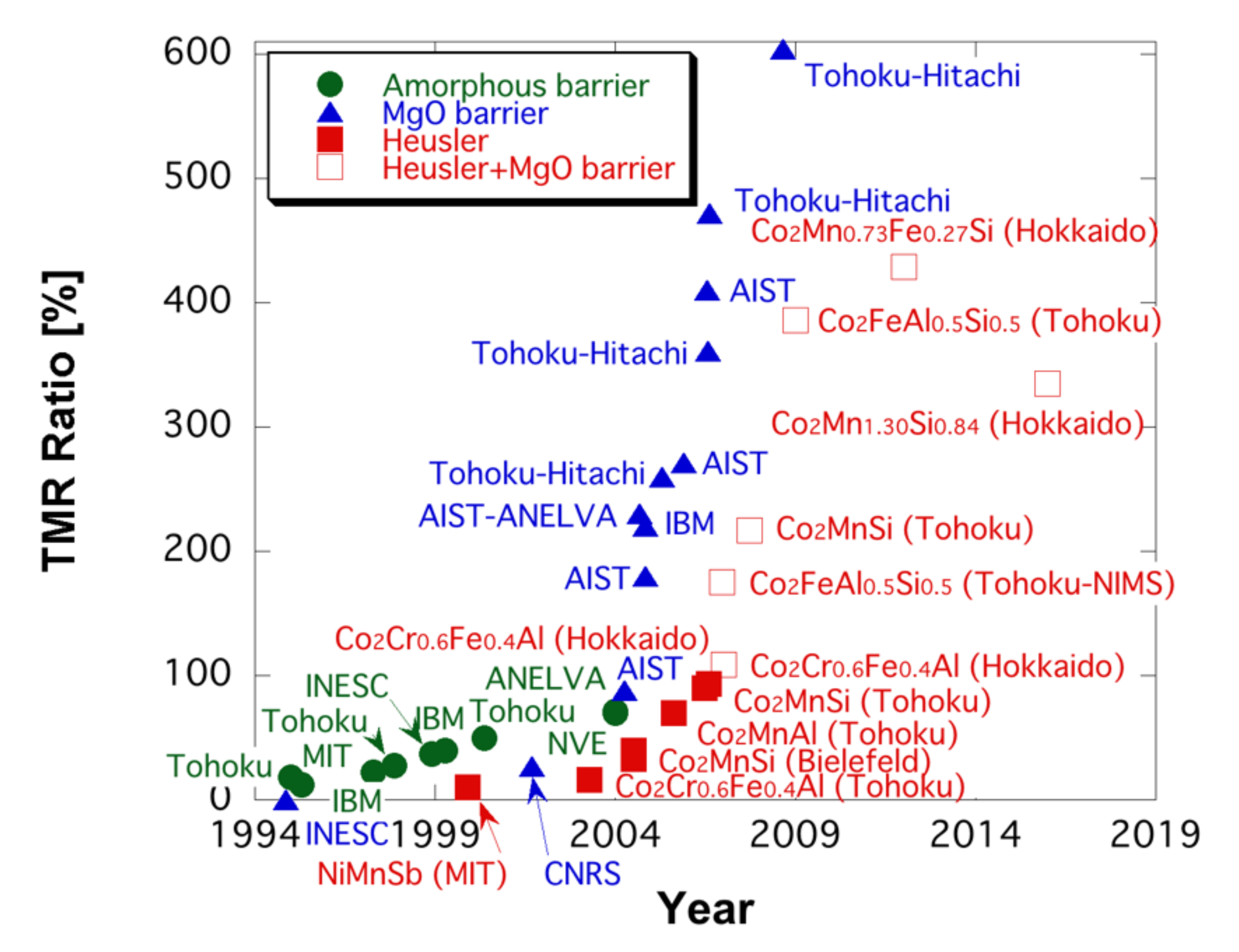Advances in Antiferromagnetic Spintronics
Funding
Data Availability Statement
Conflicts of Interest
References
- Hirohata, A.; Yamada, K.; Nakatani, Y.; Prejbeanu, L.; Diény, B.; Pirro, P.; Hillebrands, B. Review on spintronics: Principles and device applications. J. Magn. Magn. Mater. 2020, 509, 166711. [Google Scholar] [CrossRef]
- Jung, J.W.; Sakuraba, Y.; Sasaki, T.T.; Miura, Y.; Hono, K. Enhancement of magnetoresistance by inserting thin NiAl layers at the interfaces in Co2FeGa0.5Ge0.5/Ag/Co2FeGa0.5Ge0.5 current-perpendicular-to-plane pseudo spin valves. Appl. Phys. Lett. 2016, 108, 102408. [Google Scholar] [CrossRef]
- Ikeda, S.; Hayakawa, J.; Ashizawa, Y.; Lee, Y.M.; Miura, K.; Hasegawa, H.; Tsunoda, M.; Matsukura, F.; Ohno, H. Tunnel magnetoresistance of 604% at 300 K by suppression of Ta diffusion in CoFeB/MgO/CoFeB pseudo-spin-valves anneal. Appl. Phys. Lett. 2008, 93, 082508. [Google Scholar] [CrossRef]
- Elphick, K.; Frost, W.; Samiepour, M.; Kubota, T.; Takanashi, K.; Sukegawa, H.; Mitani, S.; Hirohata, A. Heusler alloys for spintronic devices: Review on recent development and future perspectives. Sci. Technol. Adv. Mater. 2020, 22, 235. [Google Scholar] [CrossRef] [PubMed]
- Néel, L. Propriétés magnétiques des ferrites. Ann. Phys. 1948, 3, 137. [Google Scholar] [CrossRef]
- Fontana, R.E., Jr.; Gurney, B.A.; Lin, T.; Speriosu, V.S.; Tsang, C.H.; Wilhoit, D.R. Spin Valve Magnetoresistive Sensor with Antiparallel Pinned Layer and Improved Exchange Bias Layer, and Magnetic Recording System Using the Sensor. U.S. Patent 5,701,223, 23 August 1996. [Google Scholar]
- Jungwirth, T.; Marti, X.; Wadley, P.; Wunderlich, J. Antiferromagnetic spintronics. Nat. Nanotech. 2016, 11, 231. [Google Scholar] [CrossRef]
- Vallejo-Fernandez, G.; Meinert, M. Recent developments on MnN for spintronic applications. Magnetochemistry 2021, 7, 116. [Google Scholar] [CrossRef]
- Shiratsuchi, Y.; Tao, Y.; Toyoki, K.; Nakatani, R. Magnetoelectric induced switching of perpendicular exchange bias using 30-nm-thick Cr2O3 thin film. Magnetochemistry 2021, 7, 36. [Google Scholar] [CrossRef]
- Huminiuc, T.; Whear, O.; Vick, A.J.; Lloyd, D.C.; Vallejo-Fernandez, G.; O’Grady, K.; Hirohata, A. Growth and characterisation of antiferromagnetic Ni2MnAl Heusler alloy films. Magnetochemistry 2021, 7, 127. [Google Scholar] [CrossRef]
- Ranjbar, S.; Sumi, S.; Tanabe, K.; Awano, H. Large perpendicular exchange energy in TbxCo100−x/Cu(t)/[Co/Pt]2 heterostructures. Magnetochemistry 2021, 7, 141. [Google Scholar] [CrossRef]
- Chen, X.; Zheng, C.; Zhou, S.; Liu, Y.; Zhang, Z. Manipulation of time- and frequency-domain dynamics by magnon-magnon coupling in synthetic antiferromagnets. Magnetochemistry 2022, 8, 7. [Google Scholar] [CrossRef]
- Safin, A.; Nikitov, S.; Kirilyuk, A.; Tyberkevych, V.; Slavin, A. Theory of antiferromagnet-based detector of terahertz frequency signals. Magnetochemistry 2022, 8, 26. [Google Scholar] [CrossRef]
- Kim, H.; Van, P.-C.; Jung, H.; Yang, J.; Jo, Y.; Yoo, J.-W.; Park, A.M.; Jeong, J.-R.; Kim, K.-J. Deposition of crystalline GdIG samples using metal organic decomposition method. Magnetochemistry 2022, 8, 28. [Google Scholar] [CrossRef]

Publisher’s Note: MDPI stays neutral with regard to jurisdictional claims in published maps and institutional affiliations. |
© 2022 by the author. Licensee MDPI, Basel, Switzerland. This article is an open access article distributed under the terms and conditions of the Creative Commons Attribution (CC BY) license (https://creativecommons.org/licenses/by/4.0/).
Share and Cite
Hirohata, A. Advances in Antiferromagnetic Spintronics. Magnetochemistry 2022, 8, 37. https://doi.org/10.3390/magnetochemistry8040037
Hirohata A. Advances in Antiferromagnetic Spintronics. Magnetochemistry. 2022; 8(4):37. https://doi.org/10.3390/magnetochemistry8040037
Chicago/Turabian StyleHirohata, Atsufumi. 2022. "Advances in Antiferromagnetic Spintronics" Magnetochemistry 8, no. 4: 37. https://doi.org/10.3390/magnetochemistry8040037
APA StyleHirohata, A. (2022). Advances in Antiferromagnetic Spintronics. Magnetochemistry, 8(4), 37. https://doi.org/10.3390/magnetochemistry8040037




